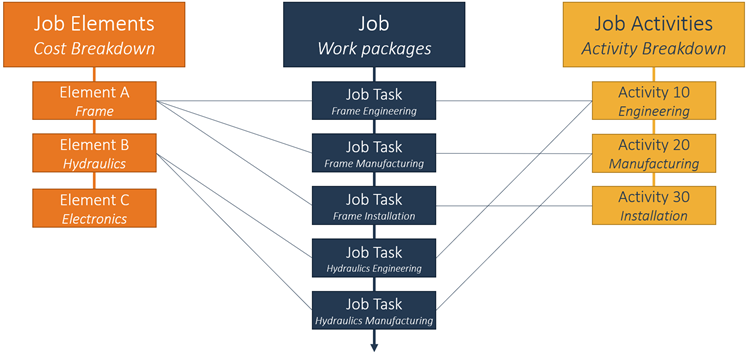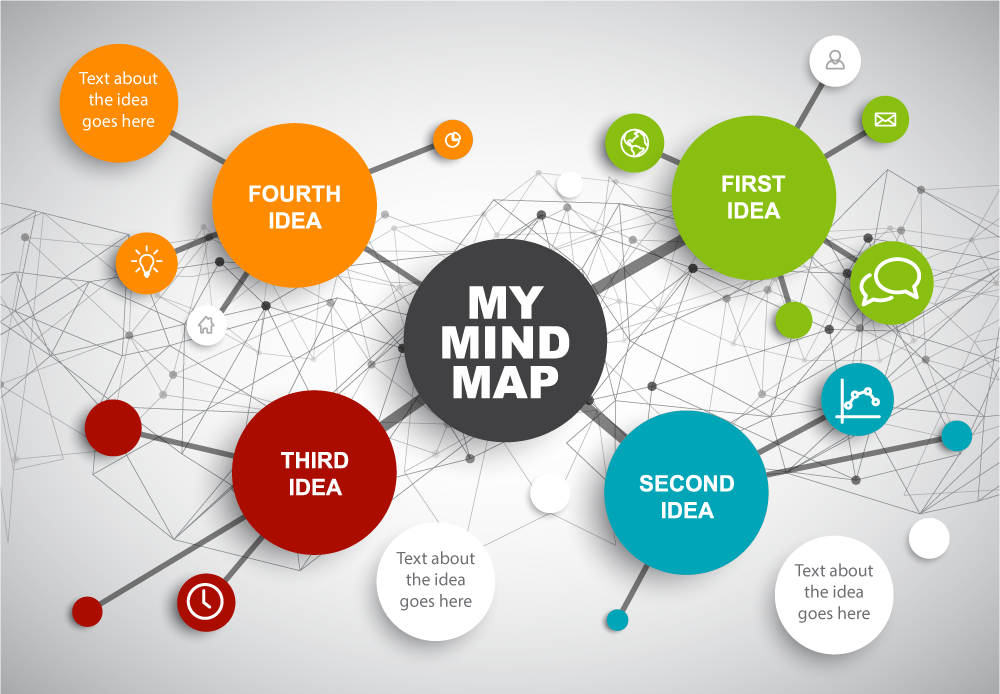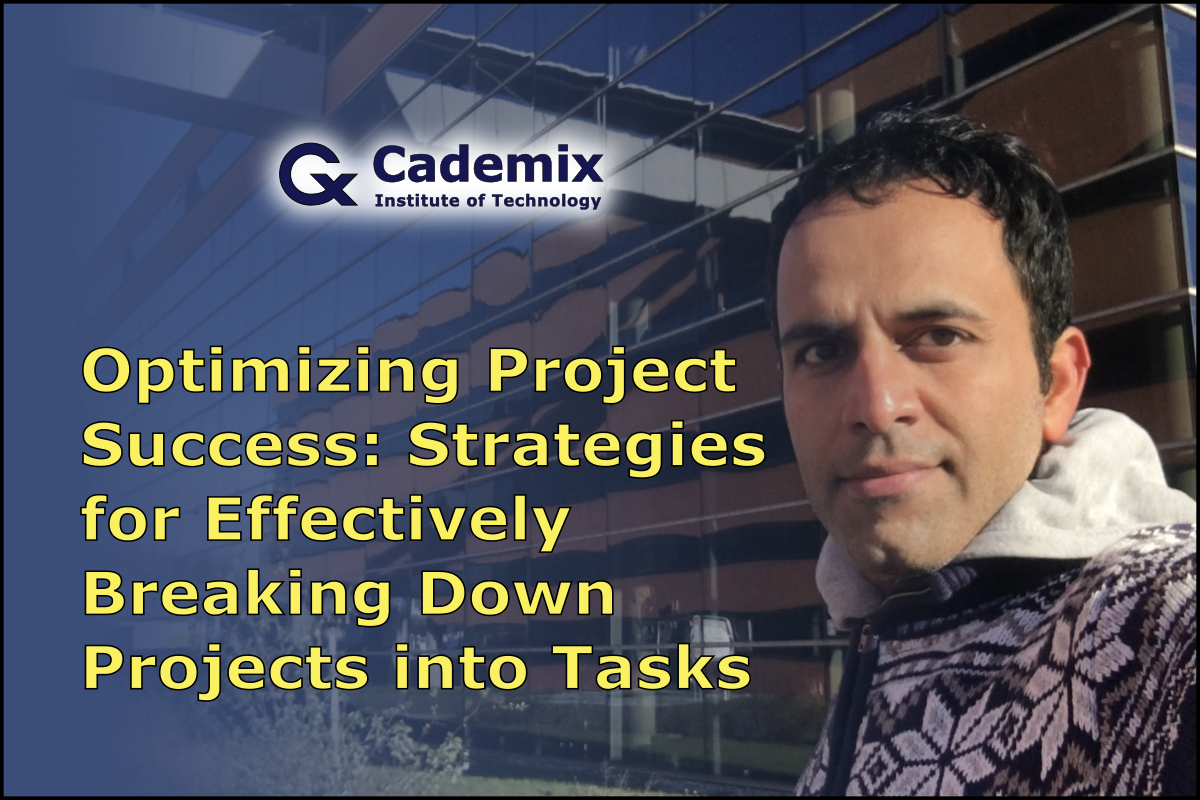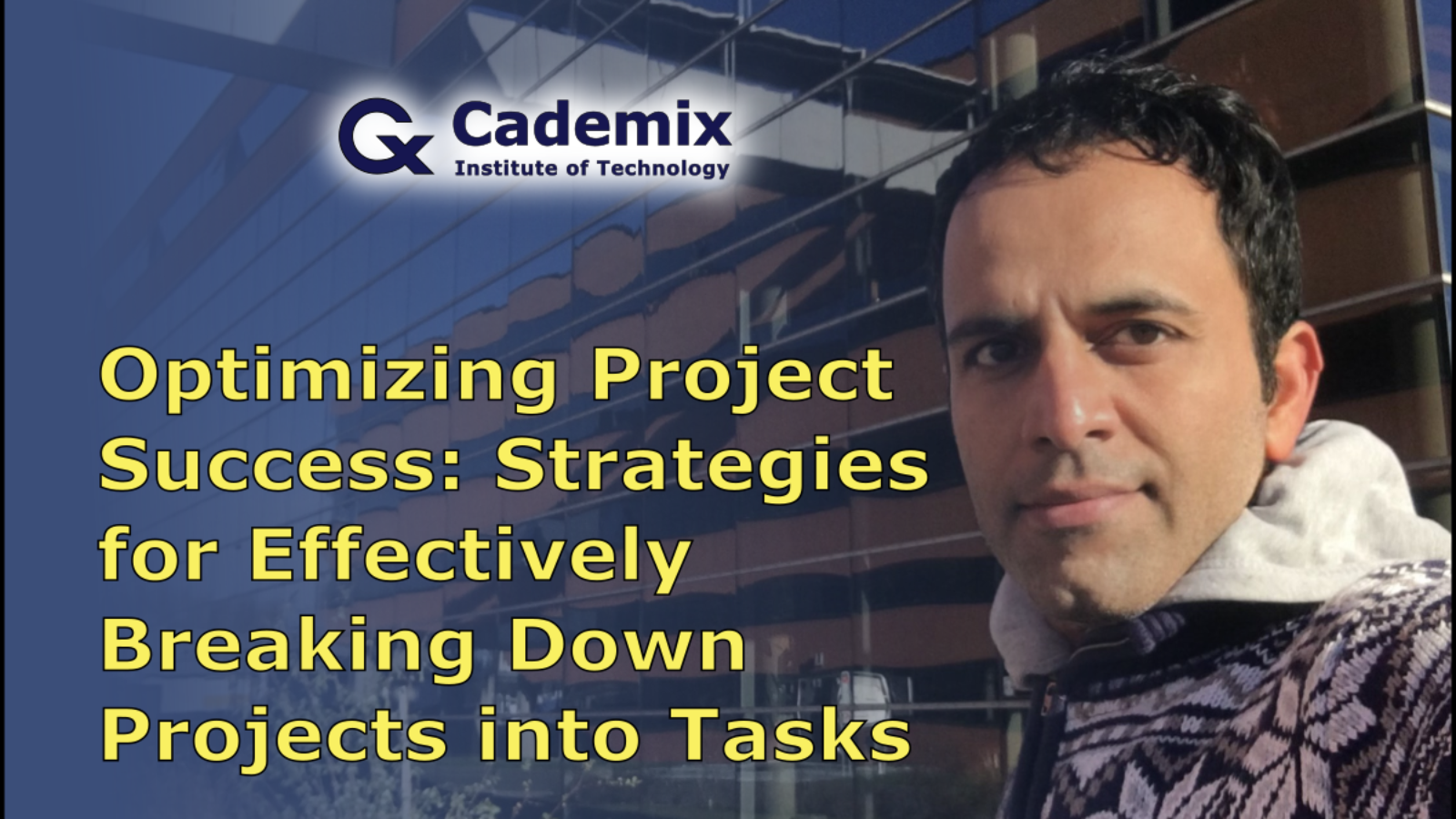In the dynamic field of project management, the key to success is the careful dissection of tasks. This is the beginning of an extensive investigation into “Optimizing Project Success: Strategies for Effectively Breaking Down Projects into Tasks.” This article provides a comprehensive yet approachable guide to project execution competence. Making it a valuable resource for potential employers in the ever-evolving area of electrical engineering. By exposing the subtleties of project breakdown, we make clear how important it is to improve operational efficiency. Explore approachable techniques like Work Breakdown Structure (WBS), Agile, Critical Path Method (CPM), Mind Mapping, and Kanban. And learn how to best utilize these tools in electrical engineering settings by demystifying them. Our investigation goes beyond conceptual models and includes case studies from actual situations.
By Ahmad Atash Afzon, Cademix Institute of Technology

Introduction
Brief overview of the importance of breaking down projects into tasks
In the fast-paced landscape of project management, success is intricately tied to the ability to decipher and organize tasks effectively. Here, we underscore the paramount significance of breaking down projects into tasks. This introductory section briefly navigates through the dynamic interplay between task breakdown and successful project management. It laying the foundation for a comprehensive exploration of strategies and methodologies tailored for optimal outcomes in various professional landscapes.
Mention of the impact on project management and successful project completion
We highlight the significant influence that effective project breakdown. It has on the general project management domains and project success in the end.
In highlighting this effect, the introduction hopes to highlight the usefulness of the upcoming tactics in “Optimizing Project Success: Strategies for Effectively Breaking Down Projects into Tasks,” laying the groundwork for a more thorough examination of the nuances of project implementation and success.
The Art of Breaking Down Projects: Key Concepts
Definition and significance of breaking down projects into tasks
In the pivotal segment discussing the definition and significance of breaking down projects into tasks, we embark on a clarifying journey. Here, we define project breakdown as the strategic dissection of overarching goals into manageable tasks, creating a roadmap for efficient project execution. This process serves as the cornerstone for heightened project clarity, facilitating a comprehensive understanding of the intricate components that collectively contribute to project success. By delving into the significance of this practice, we illuminate how it acts as a compass, guiding project managers and teams through the intricate terrain of project management. The definition and significance underscore the indispensable role that task breakdown plays in ensuring clarity, precision, and ultimately, the triumph of projects.
Overview of project decomposition and its role in project planning
In the subtopic that delves into the overview of project decomposition and its crucial role in project planning, we unpack the concept of breaking down projects into tasks as a fundamental pillar of effective project management. Here, we provide a bird’s-eye view of project decomposition, illustrating how it acts as the architectural framework that transforms lofty project goals into manageable, actionable components. This overview underscores the strategic importance of project decomposition in the meticulous planning phase, offering project managers a blueprint to navigate complexities with precision. As we explore this subtopic, the article aims to empower readers with a clear understanding of how project decomposition becomes the linchpin for organized, streamlined project planning and execution.
Discussion on how task breakdown enhances project clarity and efficiency
This section delves into the transformative impact of task breakdown on project clarity and efficiency. It illuminates the concept of dissecting overarching project goals into manageable tasks, providing a strategic roadmap for seamless project execution. This clarity, in turn, becomes a catalyst for heightened efficiency, enabling project teams to navigate complexities with precision. In succinct terms, this discussion encapsulates the essence of how task breakdown acts as a powerful tool, fostering a clear path towards more efficient and successful project outcomes.
Methods of Breaking Down Projects
Detailed exploration of various methods for breaking down projects:
Work Breakdown Structure (WBS)

The Work Breakdown Structure (WBS) is a foundational project management tool that systematically breaks down a project into discrete, manageable components. It provides a hierarchical framework, organizing tasks into a structured format. This method not only enhances project clarity by visualizing the project’s scope but also facilitates effective resource allocation and timeline planning.
In addition, WBS serves as a roadmap for project managers and teams, fostering a detailed understanding of project components, contributing significantly to successful project execution.
Agile methodologies
Agile methodologies represent a dynamic and flexible approach to project management, emphasizing iterative development and adaptability. In contrast to traditional linear project management methods, Agile encourages collaborative, cross-functional teams to work in short cycles or sprints. These iterations allow for constant reassessment and adjustment, aligning the project with evolving requirements and feedback. Agile promotes customer satisfaction by delivering incremental value throughout the project’s lifecycle. Its adaptive nature enhances responsiveness to changes, making it particularly effective in industries with rapidly evolving demands. Agile methodologies redefine how projects are approached, fostering a nimble and collaborative environment conducive to successful project outcomes.
Critical Path Method (CPM)
The Critical Path Method (CPM) is a strategic project management tool designed to identify and prioritize tasks crucial for project completion. By meticulously mapping out the sequence of tasks and their dependencies, CPM highlights the critical path—the sequence of activities that, if delayed, could impact the project timeline. This method provides project managers with a clear understanding of the most time-sensitive tasks, enabling effective resource allocation and timely decision-making. CPM is especially valuable for projects with stringent time constraints, as it allows for a focused and efficient approach to ensure project success within predetermined timelines.
Mind mapping techniques

Mind mapping techniques offer a visually intuitive approach to project breakdown, diverging from traditional linear methods. By creating a visual representation of interconnected tasks and ideas, mind mapping fosters a more holistic understanding of project components. Nodes represent tasks, and branches illustrate their relationships, providing a dynamic and adaptable overview. This technique stimulates creativity and collaboration within project teams, encouraging diverse perspectives. While particularly effective in the initial brainstorming and planning phases, mind mapping remains a valuable tool throughout the project lifecycle. Its ability to capture and organize ideas in a non-linear fashion makes it an engaging and effective method for enhancing project clarity and promoting innovative thinking.
Kanban boards
Kanban boards, inspired by lean manufacturing principles, offer a straightforward and visual way to manage tasks within a project. They consist of columns representing different stages of work (e.g., “To-Do,” “In Progress,” “Completed”) and cards representing individual tasks. As tasks progress, they move across the columns, providing a clear snapshot of the project’s status. This simplicity fosters transparency, enabling teams to easily track progress and identify potential bottlenecks. Kanban’s real-time, collaborative nature makes it particularly effective in dynamic project environments, promoting adaptive workflows and enhancing overall project efficiency.
Comparative Analysis: Breaking Down Projects vs. Alternative Approaches
SWOT analysis for breaking down projects into tasks
A SWOT analysis examines the strengths, weaknesses, opportunities, and threats of breaking down projects into tasks. This strategic evaluation method reveals the method’s inherent advantages, such as enhanced clarity and efficiency, while acknowledging potential challenges like time consumption. By understanding these internal and external factors, project teams can refine their approach for optimal outcomes.
Comparison with alternative approaches:
This section critically assesses the effectiveness of breaking down projects into tasks by comparing it to alternative approaches. It explores the unique strengths and weaknesses of the chosen method concerning project management software, traditional planning methods, and task-based management tools. By weighing these alternatives, project managers gain valuable insights into the most suitable approach for their specific project requirements.
Project management software
Project management software is examined in this section for its role in project breakdown. It explores how dedicated software facilitates task organization, collaboration, and tracking. While offering a centralized platform, potential drawbacks such as complexity or over-dependence are considered, providing a comprehensive view for project managers seeking the most fitting solution.
Traditional project planning methods
The comparison extends to traditional project planning methods, evaluating their strengths and weaknesses in contrast to task breakdown. This analysis highlights the structured nature of traditional methods and their potential limitations in handling modern project dynamics. It offers insights into the adaptability and efficiency differentials, aiding project teams in selecting an approach aligned with contemporary project demands.
Task-based project management tools
This section scrutinizes task-based project management tools and their compatibility with breaking down projects. It outlines how these tools streamline task organization and communication within teams. By examining their advantages, such as detailed task dependencies, and potential drawbacks like scalability issues, project managers gain a nuanced understanding to make informed decisions in optimizing their project management approach.
Real-world Application: Case Studies
Showcase real-world examples of successful project breakdowns
In this case study, we examined a real-world application of effective project breakdown within a dynamic engineering firm. Faced with a complex initiative to develop a groundbreaking renewable energy solution, the project team leveraged meticulous task breakdown strategies to navigate the intricacies of design, development, and implementation. By utilizing methodologies such as Agile and Work Breakdown Structure (WBS), the team dissected the project into manageable tasks, ensuring clarity in project scope and fostering adaptability.
Highlight the impact on project timelines, resource allocation, and overall success
The implementation of task breakdown techniques significantly impacted project timelines. By identifying critical paths and employing Agile sprints, the team experienced enhanced project flexibility and responsiveness to evolving requirements. This agile approach allowed for swift adjustments and ensured that project milestones were consistently met, contributing to a streamlined and punctual project delivery.
So in this stem we have Project Success as we do Breaking Down tasks into the subtasks.
Effective task breakdown had a profound effect on resource allocation within the project. The team, equipped with a clear visual representation of tasks and dependencies through WBS, strategically allocated resources based on priority and criticality.
This proactive approach optimized resource utilization, preventing bottlenecks and ensuring that the right skills were applied at the right stages of the project.
The success of this project exemplifies the transformative impact of task breakdown on overall project success. The combination of methodologies like WBS and Agile not only enhanced project clarity and efficiency but also fostered a collaborative and adaptive project environment. The renewable energy solution was delivered on time, within budget, and exceeded client expectations. This case study underscores the tangible benefits of strategic project breakdown in achieving success in complex, real-world engineering projects.
Conclusion
Summarize the importance of breaking down projects into tasks
Breaking down projects into tasks is of paramount importance as it serves as the foundational framework for successful project management. This process enhances project clarity by transforming complex goals into manageable components, fostering a clear understanding. By systematically organizing tasks, it optimizes resource allocation, improves efficiency, and facilitates timely decision-making.
Emphasize the value of this skill in project management and professional development
The skill of breaking down projects into tasks holds immense value in the realm of project management.
and contributes significantly to professional development. Proficiency in this skill ensures project managers and teams can effectively plan, organize, and execute projects with precision. It fosters transparency, allowing for better communication and collaboration within teams. Moreover, the ability to break down projects enhances problem-solving and decision-making capacities, crucial for overcoming challenges. For professional development, mastering this skill sets individuals apart, showcasing their strategic approach to project management, and positioning them as invaluable assets in any professional context.
For the table comparing similar methods:
| Method | Key Features | Advantages | Disadvantages |
|---|---|---|---|
| Work Breakdown Structure | Hierarchical decomposition | – Clear structure | – Can be time-consuming |
| Agile Methodologies | Iterative and flexible | – Adaptability | – Requires strong team communication |
| Critical Path Method | Sequencing tasks based on dependencies | – Identifies critical tasks | – Complexity in large projects |
| Mind Mapping Techniques | Visual representation of tasks | – Creativity in planning | – Limited scalability |
| Kanban Boards | Visualizing workflow in a linear manner | – Real-time task tracking | – May lack detailed task dependencies |
About the author
The author has a strong desire to educate everyone who is willing to learn. Ahmad Atash Afzon is a graduate of electrical engineering, currently a member of Cademix Career Autopilot Program in Austria. He has years of experience in the field of simulation of electrical protection system.
Ahmad has more than 9 years of experience working in oil Refineries. Also he Designs the Protection of Electrical systems, power Distribution panels and control circuits of electromotors.
His work offers practical advice, guiding readers through the complexities of choosing the right tool for their projects.
He has also extensive knowledge of Matlab programming, including visualization techniques and how to Create animation in Matlab. Please feel free to contact him, if you have any inquiries a question about the topic.

Email: ahmad.atashafzon21@gmail.com
Linkedin: linkedin.com/in/ahmad-atash-afzon-a713921b2
References
https://en.wikipedia.org/wiki/Kanbanhttps://en.wikipedia.org/wiki/Kanban
Keyword related to Optimizing: Strategies for Effectively Breaking Down Projects into Tasks
breaking down, tasks, project, management, project management, effectively breaking down projects, break down tasks

